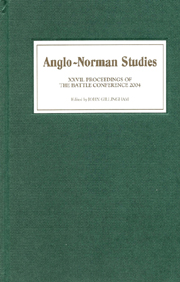Book contents
- Frontmatter
- Contents
- LIST OF ILLUSTRATIONS
- EDITOR'S PREFACE
- ABBREVIATIONS
- Probing the Passions of a Norman on Crusade: the Gesta Francorum et aliorum Hierosolimitanorum
- Gilbert Foliot et l'Ecriture, un exégète en politique
- Writing Warfare, Lordship and History: the Gesta Consulum Andegavorum's Account of the Battle of Alençon
- Anglo-French Peace Conferences in the Twelfth Century
- Peter of Blois and the Problem of the ‘Court’ in the Late Twelfth Century
- Normandy and Norman Identity in Southern Italian Chronicles
- Monastic Chronicles in the Twelfth-Century Abruzzi
- The Impact of Rebellion on Little Domesday
- Setting Things Straight: Law, Justice and Ethics in the Orationes of Lawrence of Durham
- The Angevin Kings and Canon Law: Episcopal Elections and the Loss of Normandy
- Zooarchaeology of the Norman Conquest
- Was Thomas Becket Chaste? Understanding Episodes in the Becket Lives
Monastic Chronicles in the Twelfth-Century Abruzzi
Published online by Cambridge University Press: 12 September 2012
- Frontmatter
- Contents
- LIST OF ILLUSTRATIONS
- EDITOR'S PREFACE
- ABBREVIATIONS
- Probing the Passions of a Norman on Crusade: the Gesta Francorum et aliorum Hierosolimitanorum
- Gilbert Foliot et l'Ecriture, un exégète en politique
- Writing Warfare, Lordship and History: the Gesta Consulum Andegavorum's Account of the Battle of Alençon
- Anglo-French Peace Conferences in the Twelfth Century
- Peter of Blois and the Problem of the ‘Court’ in the Late Twelfth Century
- Normandy and Norman Identity in Southern Italian Chronicles
- Monastic Chronicles in the Twelfth-Century Abruzzi
- The Impact of Rebellion on Little Domesday
- Setting Things Straight: Law, Justice and Ethics in the Orationes of Lawrence of Durham
- The Angevin Kings and Canon Law: Episcopal Elections and the Loss of Normandy
- Zooarchaeology of the Norman Conquest
- Was Thomas Becket Chaste? Understanding Episodes in the Becket Lives
Summary
The genre of chartulary-chronicles, that is a combination of an historical narrative with a substantial collection of original documents, usually pertaining to a monastic house, was relatively unusual, but far from unknown in medieval Europe. Students of Anglo-Norman England will be familiar with the Abingdon Chronicle and the Liber Eliensis, in particular, and a small number of other histories of this type were written in England and northern France, mostly in the middle or late twelfth century. While there has been a tendency to dismiss such texts as a rather inferior form of history writing, a recent study of the Liber Eliensis has reminded us that these are not just, or at least not always, ‘a jumble of documents, narrative and miracles’, and that such chartulary-chronicles, like more overtly narrative histories, could have very clear and distinct authorial strategies which were enhanced by the interplay of narrative and document. Furthermore, as Patrick Geary has pointed out, even ‘pure’ chartularies, through their principles of selection and organisation, represent an attempt to shape and re-interpret the past of the institution concerned. There are no less than five examples of the chartulary-chronicle which survive from central and southern Italy in the twelfth century, four of which come from the regions which became incorporated into the new kingdom of Sicily created by Roger II after 1130. While they display considerable differences one from another, all combine to some degree narrative text and monastic chartulary.
- Type
- Chapter
- Information
- Anglo-Norman Studies 27Proceedings of the Battle Conference 2004, pp. 101 - 131Publisher: Boydell & BrewerPrint publication year: 2005



